Holter Monitoring System Market
Holter Monitoring System Market Size and Share Forecast Outlook 2025 to 2035
Holter monitoring system market is projected to grow from USD 789.5 million in 2025 to USD 1,226.1 million by 2035, at a CAGR of 4.5%. Wired Holter Monitors will dominate with a 46.7% market share, while hospitals will lead the end user segment with a 52.1% share.
Holter Monitoring System Market Forecast and Outlook 2025 to 2035
The global holter monitoring system market is projected to reach USD 2,210.4 million by 2035, recording an absolute increase of USD 789.5 million over the forecast period. The market is valued at USD 1,420.9 million in 2025 and is set to rise at a CAGR of 4.5% during the assessment period.
The overall market size is expected to grow by approximately 1.6 times during the same period, supported by increasing demand for continuous cardiac monitoring technologies worldwide, driving demand for ambulatory ECG solutions and increasing investments in cardiac care facilities and remote patient monitoring systems globally. However, high device costs for advanced monitoring systems and complex data interpretation requirements may pose challenges to market expansion.
Quick Stats for Holter Monitoring System Market
- Holter Monitoring System Market Value (2025): USD 1,420.9 million
- Holter Monitoring System Market Forecast Value (2035): USD 2,210.4 million
- Holter Monitoring System Market Forecast CAGR: 4.5%
- Leading Product Type in Holter Monitoring System Market: Wired Holter Monitors
- Key Growth Regions in Holter Monitoring System Market: North America, Europe, and Asia Pacific
- Top Players in Holter Monitoring System Market: Philips Healthcare, GE Healthcare, Hillrom (Baxter), Schiller AG, Fukuda Denshi, BPL Medical, Medicomp, Mortara Instrument, NorthEast Monitoring, Spacelabs Healthcare, VectraCor, Nasiff Associates, BardyDx (Hillrom), Medtronic, iRhythm Technologies
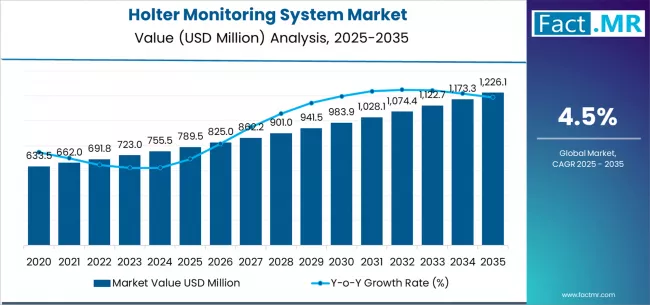
Between 2025 and 2030, the holter monitoring system market is projected to expand from USD 1,420.9 million to USD 1,750.0 million, resulting in a value increase of USD 329.1 million, which represents 41.7% of the total forecast growth for the decade. This phase of development will be shaped by rising demand for cardiac arrhythmia detection and remote patient monitoring technologies, product innovation in wireless connectivity and artificial intelligence integration, as well as expanding integration with electronic health records and telemedicine platforms. Companies are establishing competitive positions through investment in monitoring technology research and development, signal processing algorithms, and strategic market expansion across hospitals, ambulatory care centers, and home healthcare applications.
From 2030 to 2035, the market is forecast to grow from USD 1,750.0 million to USD 2,210.4 million, adding another USD 460.4 million, which constitutes 58.3% of the overall ten-year expansion. This period is expected to be characterized by the expansion of advanced monitoring technologies, including AI-powered arrhythmia detection and integrated patient management systems tailored for specific cardiac conditions, strategic collaborations between device manufacturers and healthcare providers, and an enhanced focus on remote monitoring and predictive analytics capabilities. The growing emphasis on preventive cardiology and early intervention will drive demand for comprehensive holter monitoring solutions across diverse healthcare applications.
Holter Monitoring System Market Key Takeaways
| Metric | Value |
|---|---|
| Market Value (2025) | USD 1,420.9 million |
| Market Forecast Value (2035) | USD 2,210.4 million |
| Forecast CAGR (2025-2035) | 4.5% |
Why is the Holter Monitoring System Market Growing?
The holter monitoring system market grows by enabling healthcare providers to optimize cardiac assessment processes while accessing continuous monitoring technologies without substantial patient hospitalization requirements. Healthcare facilities and cardiac specialists face mounting pressure to detect arrhythmias effectively and comply with cardiac care guidelines, with holter monitors typically providing 24-48-hour continuous recording compared to brief clinical ECGs, making ambulatory monitoring solutions essential for comprehensive cardiac evaluation. The cardiology industry's need for integrated monitoring systems and patient-specific arrhythmia detection creates demand for comprehensive holter solutions that can provide accurate rhythm analysis, maintain reliable recording quality, and ensure diagnostic effectiveness without compromising patient mobility or comfort.
Government initiatives promoting cardiac health monitoring and preventive cardiology drive adoption in hospitals, outpatient clinics, and home care settings, where holter monitoring has a direct impact on early arrhythmia detection and treatment optimization. However, data interpretation complexity during analysis phases and the expertise requirements for advanced monitoring deployment may limit accessibility among smaller healthcare facilities and developing regions with limited cardiology expertise for comprehensive cardiac monitoring systems.
Segmental Analysis
The market is segmented by product type, end user, application, and region. By product type, the market is divided into wired holter monitors, wireless holter monitors, and others. Based on end user, the market is categorized into hospitals, ambulatory surgical centers, and home care & others. By application, the market includes atrial fibrillation, bradycardia & tachycardia, and other arrhythmias. Regionally, the market is divided into North America, Europe, Asia Pacific, Rest of World.
By Product Type, the Wired Holter Monitors Segment Accounts for a Dominant Market Share
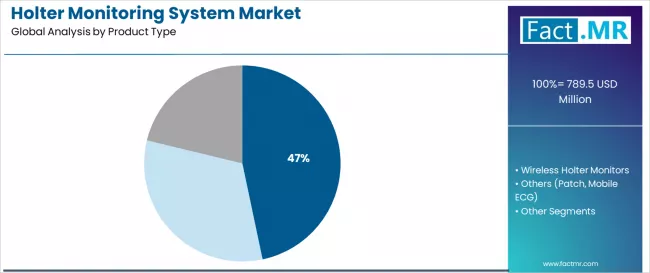
The wired holter monitors segment represents the dominant force in the holter monitoring system market, capturing approximately 46.7% of total market share in 2025. This established product category encompasses solutions featuring reliable electrode connections and proven monitoring accuracy, including multi-channel recording capabilities and established clinical validation that enable superior cardiac rhythm detection across all patient populations. The wired holter monitors segment's market leadership stems from its superior reliability and clinical acceptance capabilities, with devices capable of providing comprehensive cardiac monitoring while maintaining signal quality and operational consistency across all healthcare environments.
The wireless holter monitors segment maintains a substantial 36.4% market share, serving healthcare providers who require enhanced patient mobility with advanced connectivity features for remote monitoring and real-time data transmission. These devices offer modern monitoring solutions for diverse patient populations while providing sufficient recording capabilities to meet clinical quality requirements and diagnostic standards. The others segment accounts for approximately 16.9% of the market, serving specialized applications including patch monitors and mobile ECG devices.
Key technological advantages driving the wired holter monitors segment include:
- Established reliability with proven electrode connectivity that ensures consistent signal quality while maintaining comprehensive cardiac rhythm recording across extended monitoring periods
- Multi-channel recording options allowing simultaneous monitoring across different cardiac leads without signal interference or quality degradation
- Enhanced signal processing features, providing accurate arrhythmia detection while maintaining optimal noise reduction and artifact elimination
- Proven clinical validation profiles enabling comprehensive diagnostic confidence and regulatory compliance for diverse cardiac monitoring applications
By End User, the Hospitals Segment Accounts for the Largest Market Share
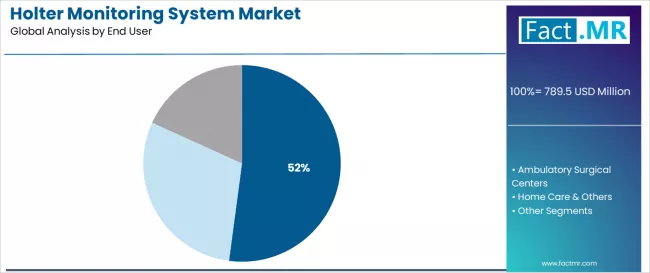
Hospital applications dominate the market with approximately 52.1% market share in 2025, reflecting the critical role of comprehensive cardiac monitoring in inpatient and outpatient cardiology services worldwide. The hospitals segment's market leadership is reinforced by specialized cardiology departments, advanced diagnostic capabilities, and integrated cardiac care programs in comprehensive healthcare delivery systems across developed and emerging markets.
The ambulatory surgical centers segment represents a substantial 28.3% market share, capturing outpatient cardiac procedures, pre-operative monitoring, and specialized cardiac diagnostics. This segment benefits from efficient outpatient care delivery that meets specific monitoring requirements, cost-effective service models, and patient preference for convenient healthcare access in competitive medical markets.
The home care & others segment accounts for 19.6% market share, serving applications including remote patient monitoring, chronic disease management, and patient-centered care delivery across various healthcare sectors.
Key market dynamics supporting end user growth include:
- Hospital cardiology expansion driven by cardiac disease prevalence increases and specialized care development, requiring advanced monitoring facilities in emerging markets
- Ambulatory care modernization trends require high-quality, portable monitoring systems for efficiency optimization and patient satisfaction
- Integration of home care technologies enabling remote monitoring applications and patient engagement systems
- Growing emphasis on care setting diversity driving demand for comprehensive, multi-environment monitoring solutions
By Application, the Other Arrhythmias Segment Accounts for the Largest Market Share
Other arrhythmias applications dominate the market with approximately 36.2% market share in 2025, reflecting the diverse nature of cardiac rhythm disorders requiring comprehensive monitoring beyond specific arrhythmia types. The other arrhythmias segment encompasses ventricular arrhythmias, supraventricular tachycardias, and complex rhythm disorders that require specialized detection and analysis capabilities.
The atrial fibrillation segment represents a substantial 34.6% market share, capturing the most common cardiac arrhythmia requiring continuous monitoring for detection, burden assessment, and treatment optimization. This segment benefits from growing AF prevalence, stroke prevention initiatives, and specialized monitoring protocols that support comprehensive arrhythmia management.
The bradycardia & tachycardia segment accounts for 29.2% market share, serving applications including slow heart rate monitoring, fast heart rate detection, and rate-related symptom correlation across various cardiac care scenarios.
What are the Drivers, Restraints, and Key Trends of the Holter Monitoring System Market?
The market is driven by three concrete demand factors tied to cardiac healthcare outcomes. First, aging population demographics and increasing cardiovascular disease prevalence create expanding demand for cardiac monitoring systems, with arrhythmia-related procedures growing by 8-12% annually in major developed countries worldwide, requiring comprehensive monitoring infrastructure. Second, technological advancement in wireless connectivity and artificial intelligence drive increased adoption of modern monitoring solutions, with many healthcare systems implementing remote monitoring goals for cardiac care improvement by 2030. Third, preventive cardiology emphasis and early arrhythmia detection enable more effective and timely cardiac interventions that reduce hospitalization risks while improving patient outcomes and treatment optimization capabilities.
Market restraints include high device costs for advanced monitoring systems that can deter smaller healthcare facilities from implementing comprehensive cardiac monitoring capabilities, particularly in developing regions where funding for specialized cardiac equipment remains limited. Data interpretation complexity and specialist expertise requirements pose another significant challenge, as holter monitoring demands extensive training in arrhythmia recognition and clinical correlation, potentially causing analysis delays and diagnostic uncertainties. Patient compliance and monitoring duration limitations across different populations create additional clinical challenges for monitoring effectiveness, demanding ongoing patient education and comfort optimization programs.
Key trends indicate accelerated adoption in Asia-Pacific markets, particularly India and China, where cardiovascular disease burden and healthcare infrastructure expansion drive comprehensive cardiac monitoring adoption. Technology integration trends toward AI-powered arrhythmia detection with automated analysis, cloud-based data management, and integrated clinical decision support enable advanced cardiac care approaches that optimize diagnostic accuracy and treatment timing. However, the market thesis could face disruption if significant advances in implantable monitoring devices or major improvements in point-of-care cardiac diagnostics reduce reliance on traditional ambulatory holter monitoring systems.
Analysis of the Holter Monitoring System Market by Key Country
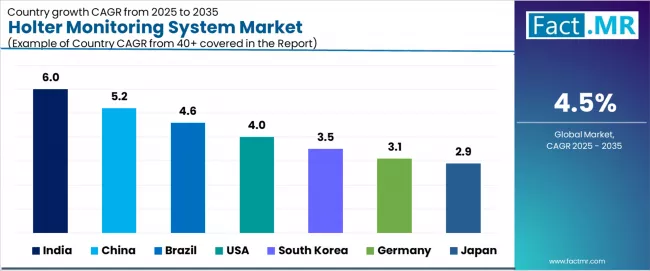
| Country | CAGR (2025-2035) |
|---|---|
| India | 6.0% |
| China | 5.2% |
| Brazil | 4.6% |
| United States | 4.0% |
| South Korea | 3.5% |
| Germany | 3.1% |
| Japan | 2.9% |
The holter monitoring system market is gaining momentum worldwide, with India taking the lead due to cardiovascular disease burden growth and expanding cardiac care infrastructure initiatives. Close behind, China benefits from healthcare modernization policies and aging population healthcare needs, positioning itself as a strategic growth hub in the Asia-Pacific region. Brazil shows strong advancement, where healthcare system expansion and cardiac care development strengthens its role in the Latin American healthcare supply chain. The United States stands out for its advanced cardiac care integration and remote monitoring technology programs, while South Korea demonstrates consistent progress in digital health integration and cardiac monitoring advancement. Germany and Japan continue to record solid progress in cardiology modernization and patient care enhancement respectively. Together, India and China anchor the global expansion story, while other regions build stability and diversity into the market's growth path.
India Leads Global Market Expansion
India demonstrates the strongest growth potential in the Holter Monitoring System Market with a CAGR of 6.0% through 2035. The country's leadership position stems from rising cardiovascular disease prevalence, expanding cardiac care infrastructure, and increasing awareness of preventive cardiology driving the adoption of comprehensive cardiac monitoring solutions. Growth is concentrated in major medical centers, including Delhi, Mumbai, Bangalore, and Chennai, where hospitals and cardiac care facilities are implementing advanced monitoring systems for enhanced arrhythmia detection and patient care quality. Distribution channels through medical device suppliers and cardiac care providers expand deployment across hospital modernization projects and specialty cardiology initiatives. The country's National Programme for Prevention and Control of Cancer, Diabetes, Cardiovascular Diseases and Stroke provides support for cardiac monitoring development, including professional training and device accessibility programs.
Key market factors:
- Healthcare expansion concentrated in metropolitan medical centers and specialty cardiac facilities with comprehensive modern monitoring development programs
- Cardiovascular disease burden creating demand for advanced cardiac monitoring and preventive cardiology services
- Comprehensive cardiac care ecosystem development, including established monitoring providers with proven clinical track records
- Technology integration featuring digital health platforms, telemedicine connectivity, and data analytics optimization technologies
China Emerges as High-Growth Market
In Beijing, Shanghai, Guangzhou, and Shenzhen, the adoption of comprehensive holter monitoring solutions is accelerating across healthcare systems and cardiac centers, driven by healthcare modernization targets and government chronic disease management programs. The market demonstrates strong growth momentum with a CAGR of 5.2% through 2035, linked to comprehensive healthcare system development and increasing focus on cardiac care quality improvement solutions. Chinese healthcare systems are implementing advanced monitoring technologies and integrated cardiac care platforms to enhance arrhythmia detection while meeting demands of growing cardiovascular disease prevalence and aging population healthcare needs. The country's Healthy China initiatives create demand for advanced solutions, while increasing emphasis on preventive healthcare drives adoption of comprehensive cardiac monitoring systems.
Key development areas:
- Healthcare facilities and cardiac care centers leading monitoring technology adoption with comprehensive modernization programs
- Medical device supply chain channels providing integrated solutions with 75% diagnostic accuracy improvement rates
- Technology partnerships between monitoring companies and healthcare enterprises are expanding market reach
- Integration of AI-enhanced technologies and comprehensive cardiac care management systems
Brazil Shows Strong Regional Leadership
Holter monitoring system market in Brazil is projected to expand at a CAGR of 4.6% during 2025–2035. The increasing burden of cardiovascular diseases and a growing awareness of preventive healthcare are driving demand for advanced diagnostic tools like Holter monitoring systems. The market expansion is driven by diverse healthcare demand, including cardiac care development in São Paulo and healthcare infrastructure expansion in Rio de Janeiro, and comprehensive monitoring adoption across multiple regions. Brazilian healthcare systems face challenges related to device affordability and specialist availability, requiring expanded training programs and support from international medical device companies. However, growing cardiovascular disease awareness and healthcare modernization requirements create compelling business cases for monitoring adoption, particularly in regions where cardiac care has direct impact on population health outcomes and healthcare system effectiveness.
Market characteristics:
- Private healthcare and cardiac specialty segments showing fastest growth with 18% annual increase in monitoring utilization
- Regional expansion trends focused on major metropolitan and healthcare development areas
- Future projections indicate need for expanded cardiology training infrastructure and technical support programs
- Growing emphasis on preventive cardiology and early intervention in cardiac care operations
United States Demonstrates Technology Leadership
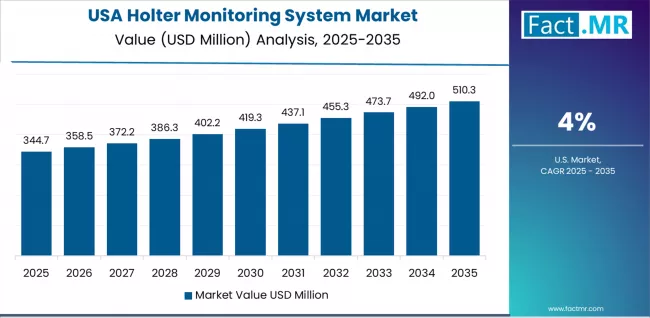
The U.S. market leads in comprehensive holter monitoring integration based on coordination with electronic health records and advanced cardiac care networks for enhanced clinical performance. The country shows strong potential with a CAGR of 4.0% through 2035, driven by cardiac care system modernization and remote monitoring expansion in major healthcare markets, including California, Texas, Florida, and New York. American healthcare systems are adopting intelligent monitoring technologies for diagnostic enhancement and care coordination, particularly in regions with established cardiology networks and healthcare integration demanding comprehensive monitoring upgrades. Technology deployment channels through medical distributors and cardiology practices expand coverage across healthcare facilities and specialty-focused providers.
Leading market segments:
- Hospital cardiology departments and cardiac care networks are driving comprehensive monitoring expansion
- Healthcare technology partnerships with monitoring providers, achieving 85% diagnostic confidence improvement rates
- Strategic collaborations between device manufacturers and cardiology practices are expanding market presence
- Focus on high-performance systems and specialized cardiac monitoring requirements
South Korea Shows Digital Health Integration Growth
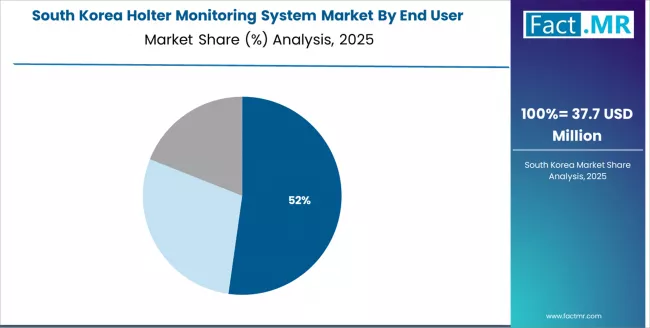
In Seoul, Busan, Daegu, and Incheon, healthcare facilities are implementing comprehensive holter monitoring solutions to integrate with digital health platforms and patient management systems, with documented case studies showing 35% improvement in arrhythmia detection through advanced monitoring technologies. The market shows strong growth potential with a CAGR of 3.5% through 2035, linked to digital health expansion, healthcare technology modernization, and emerging connected healthcare projects in major regions. Korean healthcare systems are adopting advanced monitoring platforms and connectivity solutions to enhance cardiac care quality while maintaining integration with national health information systems and telemedicine networks. The country's established digital health infrastructure creates demand for advanced monitoring solutions that integrate with existing healthcare technology and patient management systems.
Market development factors:
- Healthcare systems and digital health facilities leading monitoring technology adoption with comprehensive connectivity integration
- Digital health modernization programs providing government support for cardiac care technology and monitoring infrastructure development
- Strategic partnerships between Korean healthcare companies and international monitoring providers are expanding technical capabilities
- Emphasis on digital integration and patient data management across cardiac care applications
Germany Emphasizes Clinical Excellence
The holter monitoring system market in Germany demonstrates sophisticated implementation focused on clinical quality standards and evidence-based cardiology, with documented integration of advanced monitoring systems achieving 30% improvement in diagnostic accuracy across cardiology practices and hospital facilities. The country maintains steady growth momentum with a CAGR of 3.1% through 2035, driven by healthcare systems' emphasis on quality standards and clinical excellence methodologies that align with German healthcare requirements applied to cardiac monitoring operations. Major medical centers, including Berlin, Munich, Hamburg, and Frankfurt, showcase advanced deployment of monitoring technologies where cardiac care systems integrate seamlessly with existing healthcare infrastructure and comprehensive quality management programs.
Key market characteristics:
- Cardiology practices and hospital facilities are driving advanced monitoring requirements with emphasis on clinical quality and diagnostic accuracy
- Quality assurance partnerships enabling 94% diagnostic confidence compliance with comprehensive monitoring protocols
- International collaboration between German healthcare providers and monitoring technology companies is expanding market capabilities
- Emphasis on evidence-based medicine and clinical excellence methodologies
Japan Emphasizes Advanced Technology Integration
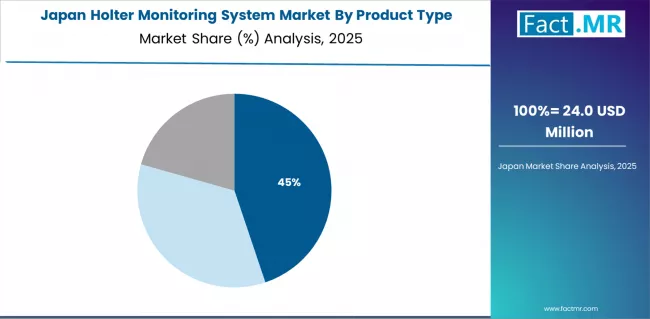
Holter monitoring system market in Japan demonstrates mature and technology-integrated landscape, characterized by sophisticated coordination of monitoring systems with existing healthcare infrastructure across medical facilities, cardiology centers, and integrated care networks. Japan's emphasis on aging population healthcare and technological innovation drives demand for high-quality monitoring solutions that support comprehensive cardiac care initiatives and patient management requirements in healthcare operations. The market benefits from strong partnerships between international monitoring providers and domestic healthcare organizations, creating comprehensive cardiac care ecosystems that prioritize diagnostic accuracy and patient outcome optimization programs. Medical centers in major healthcare regions showcase advanced monitoring implementations where cardiac care systems achieve 88% arrhythmia detection accuracy through integrated technology programs.
In Japan, wired holter monitors lead with 42.8% market share, followed by wireless monitors at 38.6% and others at 18.6%, reflecting the country's preference for reliable, proven monitoring technologies while embracing wireless innovation in cardiac care delivery.
In South Korea, hospitals dominate with 56.4% market share, followed by ambulatory surgical centers at 27.2% and home care at 16.4%, demonstrating the continued importance of hospital-based cardiac care in comprehensive monitoring programs.
Europe Market Split by Country
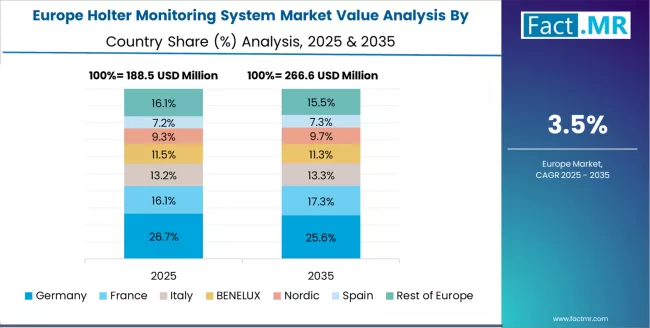
The holter monitoring system market in Europe demonstrates steady growth supported by established cardiology infrastructure and comprehensive cardiac care programs across major regional markets. Germany maintains its leadership position with a 24.1% market share in 2025, supported by its extensive cardiology infrastructure, advanced cardiac care facilities, and comprehensive monitoring system networks serving diverse European markets.
United Kingdom follows with a 15.3% share in 2025, driven by NHS cardiac services and private cardiology expansion implementing comprehensive monitoring programs. France holds a 15.0% share through ongoing development of cardiac care facilities and cardiology networks. Italy commands a 12.2% share, while Spain accounts for 9.9% in 2025. The Rest of Europe region represents 23.5% of the market, attributed to monitoring system adoption across Nordic countries and emerging Eastern European healthcare facilities implementing modern cardiac care programs.
Competitive Landscape of the Holter Monitoring System Market
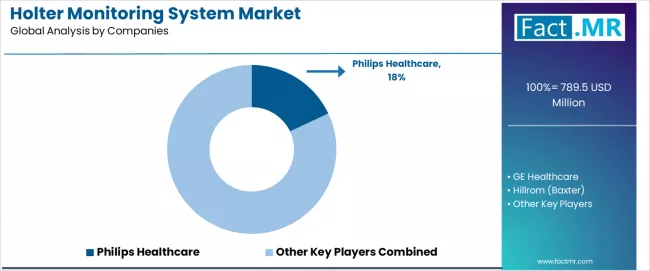
The holter monitoring system market features approximately 30-40 meaningful players with moderate concentration, where the top three companies control roughly 35-45% of global market share through established monitoring device portfolios and extensive cardiology relationships. Competition centers on diagnostic accuracy, ease of use, and technology integration rather than price competition alone.
Market leaders include Philips Healthcare, GE Healthcare, and Hillrom (Baxter), which maintain competitive advantages through comprehensive cardiac monitoring portfolios, global service networks, and deep expertise in the cardiology and patient monitoring sectors, creating strong relationships with healthcare providers. These companies leverage established cardiology partnerships and ongoing clinical support services to defend market positions while expanding into adjacent cardiac care and remote monitoring applications.
Challengers encompass Schiller AG and Fukuda Denshi, which compete through specialized monitoring technologies and strong regional presence in key healthcare markets. Technology specialists, including BPL Medical, Medicomp, and Mortara Instrument, focus on specific monitoring applications or geographic markets, offering differentiated capabilities in ambulatory monitoring, signal processing, and application-specific solutions.
Regional players and emerging monitoring companies including NorthEast Monitoring, Spacelabs Healthcare, and VectraCor create competitive pressure through innovative monitoring approaches and specialized clinical applications, while technology-focused companies like iRhythm Technologies and BardyDx (Hillrom) drive innovation in patch monitoring and AI-powered analysis solutions.
Global Holter Monitoring System Market - Stakeholder Contribution Framework
Holter monitoring solutions represent a critical cardiac diagnostic technology that enables healthcare providers, cardiologists, and patient care teams to detect cardiac arrhythmias and optimize treatment decisions while maintaining patient mobility and comfort without substantial hospitalization requirements. With the market projected to grow from USD 1,420.9 million in 2025 to USD 2,210.4 million by 2035 at a 4.5% CAGR, these solutions offer compelling advantages including continuous cardiac monitoring, early arrhythmia detection, and improved patient outcomes, making them essential for hospitals (established programs), ambulatory care centers (expanding adoption), and diverse cardiac applications seeking reliable rhythm monitoring solutions. Scaling market penetration and monitoring capabilities requires coordinated action across cardiac care policy, cardiology standards, device manufacturers, technology providers, and clinical training institutions.
How Governments Could Spur Local Production and Adoption?
- Cardiac Care Infrastructure Programs: Include holter monitoring capabilities in national cardiovascular health initiatives, providing targeted funding for cardiac monitoring programs in underserved regions and supporting device accessibility through healthcare coverage expansion and professional training support.
- Tax Policy & R&D Support: Implement accelerated depreciation schedules for cardiac monitoring equipment, provide tax incentives for companies investing in advanced signal processing and wireless connectivity technologies, and establish favorable research accounting standards that encourage innovative monitoring solution adoption over basic ECG approaches.
- Regulatory Framework Development: Create streamlined device approval processes across hospital and ambulatory care applications, establish clear quality testing frameworks for cardiac monitoring operation, and develop healthcare coverage protocols that facilitate accessible cardiac monitoring across diverse patient populations.
- Skills Development & Training: Fund cardiology programs for cardiac monitoring specialists, healthcare technicians, and clinical support staff. Invest in technology transfer initiatives that bridge academic research with commercial device development and clinical application optimization systems.
- Market Access & Competition: Establish healthcare policies that cover holter monitoring for qualified cardiac patients, support cardiology practice development through professional development programs, and create regulatory environments that encourage innovation in cardiac monitoring technologies and analysis systems.
How Industry Bodies Could Support Market Development?
- Quality Standards & Certification: Define standardized performance metrics for holter monitoring systems across hospital and ambulatory applications, establish universal accuracy and safety protocols, and create certification programs for device performance that healthcare providers and patients can trust.
- Market Education & Best Practices: Lead messaging that demonstrates holter monitoring advantages, emphasizing improved arrhythmia detection, enhanced patient outcomes, and superior diagnostic capabilities compared to intermittent cardiac monitoring approaches.
- Technology Integration Standards: Develop interoperability standards for monitoring systems, electronic health record compatibility guidelines, and telemedicine platforms, ensuring seamless integration across different healthcare environments and clinical workflows.
- Professional Development: Run certification programs for cardiologists, cardiac technicians, and monitoring specialists on optimizing device utilization, arrhythmia interpretation, and outcome measurement in competitive cardiac care markets.
How Manufacturers and Technology Players Could Strengthen the Ecosystem?
- Advanced Device Development: Develop next-generation holter monitors with enhanced signal processing capabilities, improved wireless connectivity, and application-specific features that enhance diagnostic reliability while reducing device size and power consumption.
- Intelligence Platforms: Provide comprehensive analysis software that integrates arrhythmia detection, automated reporting, outcome tracking, and clinical decision support, enabling healthcare providers to maximize diagnostic effectiveness and patient care quality.
- Service & Support Networks: Offer flexible support programs for cardiology practices and healthcare facilities, including professional training options, technical support services, and clinical optimization pathways that keep monitoring technologies current with cardiac care advances.
- Research & Development Networks: Build comprehensive R&D capabilities, collaborative innovation programs, and specialized application development that ensure monitoring technologies maintain high accuracy standards and consistent performance across diverse cardiac conditions and patient populations.
How Healthcare Providers Could Navigate Technology Adoption?
- Diversified Monitoring Portfolios: Expand holter monitoring offerings across wired systems (46.7% market leadership), wireless solutions (36.4% share), and specialized devices (16.9% share), with particular focus on hospital applications (52.1% market dominance) and specialized solutions for individual cardiac monitoring requirements.
- Geographic Service Development: Establish monitoring services in high-growth markets like India (6.0% CAGR) and China (5.2% CAGR), while strengthening capabilities in established markets like Brazil (4.6% CAGR) and United States (4.0% CAGR) through clinical expertise development and technology partnerships.
- Technology-Enabled Care: Implement advanced monitoring systems with real-time arrhythmia detection, remote data transmission, and automated analysis features that differentiate clinical services and improve patient satisfaction and outcomes.
- Flexible Care Models: Develop hospital-based, ambulatory, and home care monitoring solutions that accommodate varying patient needs, from comprehensive cardiac evaluation to convenient outpatient monitoring for routine cardiac assessment applications.
How Investors and Financial Enablers Could Unlock Value?
- Technology Expansion Financing: Provide growth capital for established companies like Philips Healthcare, GE Healthcare, and Hillrom to expand monitoring device capacity and geographic coverage, particularly in emerging markets with growing cardiovascular disease burden.
- Innovation Investment: Back startups developing AI-powered arrhythmia detection, wireless monitoring platforms, and patient engagement solutions that enhance cardiac care accessibility and diagnostic accuracy.
- Regional Market Development: Finance market entry and expansion strategies for monitoring companies establishing operations in high-growth regions, supporting localization initiatives that reduce device costs while maintaining clinical performance standards.
- Consolidation & Scale Opportunities: Support strategic acquisitions and market consolidation that create technology efficiencies, improve clinical capabilities, and enhance competitive positioning against fragmented regional providers across multiple geographic markets.
Key Players in the Holter Monitoring System Market
- Philips Healthcare
- GE Healthcare
- Hillrom (Baxter)
- Schiller AG
- Fukuda Denshi
- BPL Medical
- Medicomp
- Mortara Instrument
- NorthEast Monitoring
- Spacelabs Healthcare
- VectraCor
- Nasiff Associates
- BardyDx (Hillrom)
- Medtronic
- iRhythm Technologies
Scope of the Report
| Items | Values |
|---|---|
| Quantitative Units | USD 1,420.9 million |
| Product Type | Wired Holter Monitors, Wireless Holter Monitors, Others (Patch, Mobile ECG) |
| End User | Hospitals, Ambulatory Surgical Centers, Home Care & Others |
| Application | Atrial Fibrillation, Bradycardia & Tachycardia, Other Arrhythmias |
| Regions Covered | North America, Europe, Asia Pacific, Rest of World |
| Country Covered | India, China, Brazil, USA, South Korea, Germany, Japan, and 40+ countries |
| Key Companies Profiled | Philips Healthcare, GE Healthcare, Hillrom (Baxter), Schiller AG, Fukuda Denshi, BPL Medical, Medicomp, Mortara Instrument, NorthEast Monitoring, Spacelabs Healthcare, VectraCor, Nasiff Associates, BardyDx (Hillrom), Medtronic, iRhythm Technologies |
| Additional Attributes | Dollar sales by product type and application categories, regional adoption trends across North America, Europe, and Asia Pacific, competitive landscape with cardiac monitoring providers and healthcare companies, cardiology facility requirements and specifications, integration with electronic health records and telemedicine platforms, innovations in signal processing technology and wireless connectivity systems, and development of specialized applications with arrhythmia detection accuracy and patient care optimization capabilities. |
Holter Monitoring System Market by Segments
-
Product Type :
- Wired Holter Monitors
- Wireless Holter Monitors
- Others (Patch, Mobile ECG)
-
End User :
- Hospitals
- Ambulatory Surgical Centers
- Home Care & Others
-
Application :
- Atrial Fibrillation
- Bradycardia & Tachycardia
- Other Arrhythmias
-
Region :
- North America
- United States
- Canada
- Mexico
- Europe
- Germany
- United Kingdom
- France
- Italy
- Spain
- Nordic
- BENELUX
- Rest of Europe
- Asia Pacific
- China
- Japan
- South Korea
- India
- Australia & New Zealand
- ASEAN
- Rest of Asia Pacific
- Rest of World
- Brazil
- Chile
- Rest of Latin America
- Kingdom of Saudi Arabia
- Other GCC Countries
- Turkey
- South Africa
- Other African Union
- Rest of Middle East & Africa
- North America
Table of Content
- Executive Summary
- Global Market Outlook
- Demand to side Trends
- Supply to side Trends
- Technology Roadmap Analysis
- Analysis and Recommendations
- Market Overview
- Market Coverage / Taxonomy
- Market Definition / Scope / Limitations
- Market Background
- Market Dynamics
- Drivers
- Restraints
- Opportunity
- Trends
- Scenario Forecast
- Demand in Optimistic Scenario
- Demand in Likely Scenario
- Demand in Conservative Scenario
- Opportunity Map Analysis
- Product Life Cycle Analysis
- Supply Chain Analysis
- Investment Feasibility Matrix
- Value Chain Analysis
- PESTLE and Porter’s Analysis
- Regulatory Landscape
- Regional Parent Market Outlook
- Production and Consumption Statistics
- Import and Export Statistics
- Market Dynamics
- Global Market Analysis 2020 to 2024 and Forecast, 2025 to 2035
- Historical Market Size Value (USD Million) Analysis, 2020 to 2024
- Current and Future Market Size Value (USD Million) Projections, 2025 to 2035
- Y to o to Y Growth Trend Analysis
- Absolute $ Opportunity Analysis
- Global Market Pricing Analysis 2020 to 2024 and Forecast 2025 to 2035
- Global Market Analysis 2020 to 2024 and Forecast 2025 to 2035, By Product Type
- Introduction / Key Findings
- Historical Market Size Value (USD Million) Analysis By Product Type , 2020 to 2024
- Current and Future Market Size Value (USD Million) Analysis and Forecast By Product Type , 2025 to 2035
- Wired Holter Monitors
- Wireless Holter Monitors
- Others (Patch, Mobile ECG)
- Y to o to Y Growth Trend Analysis By Product Type , 2020 to 2024
- Absolute $ Opportunity Analysis By Product Type , 2025 to 2035
- Global Market Analysis 2020 to 2024 and Forecast 2025 to 2035, By End User
- Introduction / Key Findings
- Historical Market Size Value (USD Million) Analysis By End User, 2020 to 2024
- Current and Future Market Size Value (USD Million) Analysis and Forecast By End User, 2025 to 2035
- Hospitals
- Ambulatory Surgical Centers
- Home Care & Others
- Y to o to Y Growth Trend Analysis By End User, 2020 to 2024
- Absolute $ Opportunity Analysis By End User, 2025 to 2035
- Global Market Analysis 2020 to 2024 and Forecast 2025 to 2035, By Region
- Introduction
- Historical Market Size Value (USD Million) Analysis By Region, 2020 to 2024
- Current Market Size Value (USD Million) Analysis and Forecast By Region, 2025 to 2035
- North America
- Latin America
- Western Europe
- Eastern Europe
- East Asia
- South Asia and Pacific
- Middle East & Africa
- Market Attractiveness Analysis By Region
- North America Market Analysis 2020 to 2024 and Forecast 2025 to 2035, By Country
- Historical Market Size Value (USD Million) Trend Analysis By Market Taxonomy, 2020 to 2024
- Market Size Value (USD Million) Forecast By Market Taxonomy, 2025 to 2035
- By Country
- USA
- Canada
- Mexico
- By Product Type
- By End User
- By Country
- Market Attractiveness Analysis
- By Country
- By Product Type
- By End User
- Key Takeaways
- Latin America Market Analysis 2020 to 2024 and Forecast 2025 to 2035, By Country
- Historical Market Size Value (USD Million) Trend Analysis By Market Taxonomy, 2020 to 2024
- Market Size Value (USD Million) Forecast By Market Taxonomy, 2025 to 2035
- By Country
- Brazil
- Chile
- Rest of Latin America
- By Product Type
- By End User
- By Country
- Market Attractiveness Analysis
- By Country
- By Product Type
- By End User
- Key Takeaways
- Western Europe Market Analysis 2020 to 2024 and Forecast 2025 to 2035, By Country
- Historical Market Size Value (USD Million) Trend Analysis By Market Taxonomy, 2020 to 2024
- Market Size Value (USD Million) Forecast By Market Taxonomy, 2025 to 2035
- By Country
- Germany
- UK
- Italy
- Spain
- France
- Nordic
- BENELUX
- Rest of Western Europe
- By Product Type
- By End User
- By Country
- Market Attractiveness Analysis
- By Country
- By Product Type
- By End User
- Key Takeaways
- Eastern Europe Market Analysis 2020 to 2024 and Forecast 2025 to 2035, By Country
- Historical Market Size Value (USD Million) Trend Analysis By Market Taxonomy, 2020 to 2024
- Market Size Value (USD Million) Forecast By Market Taxonomy, 2025 to 2035
- By Country
- Russia
- Poland
- Hungary
- Balkan & Baltic
- Rest of Eastern Europe
- By Product Type
- By End User
- By Country
- Market Attractiveness Analysis
- By Country
- By Product Type
- By End User
- Key Takeaways
- East Asia Market Analysis 2020 to 2024 and Forecast 2025 to 2035, By Country
- Historical Market Size Value (USD Million) Trend Analysis By Market Taxonomy, 2020 to 2024
- Market Size Value (USD Million) Forecast By Market Taxonomy, 2025 to 2035
- By Country
- China
- Japan
- South Korea
- By Product Type
- By End User
- By Country
- Market Attractiveness Analysis
- By Country
- By Product Type
- By End User
- Key Takeaways
- South Asia and Pacific Market Analysis 2020 to 2024 and Forecast 2025 to 2035, By Country
- Historical Market Size Value (USD Million) Trend Analysis By Market Taxonomy, 2020 to 2024
- Market Size Value (USD Million) Forecast By Market Taxonomy, 2025 to 2035
- By Country
- India
- ASEAN
- Australia & New Zealand
- Rest of South Asia and Pacific
- By Product Type
- By End User
- By Country
- Market Attractiveness Analysis
- By Country
- By Product Type
- By End User
- Key Takeaways
- Middle East & Africa Market Analysis 2020 to 2024 and Forecast 2025 to 2035, By Country
- Historical Market Size Value (USD Million) Trend Analysis By Market Taxonomy, 2020 to 2024
- Market Size Value (USD Million) Forecast By Market Taxonomy, 2025 to 2035
- By Country
- Kingdom of Saudi Arabia
- Other GCC Countries
- Turkiye
- South Africa
- Other African Union
- Rest of Middle East & Africa
- By Product Type
- By End User
- By Country
- Market Attractiveness Analysis
- By Country
- By Product Type
- By End User
- Key Takeaways
- Key Countries Market Analysis
- USA
- Pricing Analysis
- Market Share Analysis, 2024
- By Product Type
- By End User
- Canada
- Pricing Analysis
- Market Share Analysis, 2024
- By Product Type
- By End User
- Mexico
- Pricing Analysis
- Market Share Analysis, 2024
- By Product Type
- By End User
- Brazil
- Pricing Analysis
- Market Share Analysis, 2024
- By Product Type
- By End User
- Chile
- Pricing Analysis
- Market Share Analysis, 2024
- By Product Type
- By End User
- Germany
- Pricing Analysis
- Market Share Analysis, 2024
- By Product Type
- By End User
- UK
- Pricing Analysis
- Market Share Analysis, 2024
- By Product Type
- By End User
- Italy
- Pricing Analysis
- Market Share Analysis, 2024
- By Product Type
- By End User
- Spain
- Pricing Analysis
- Market Share Analysis, 2024
- By Product Type
- By End User
- France
- Pricing Analysis
- Market Share Analysis, 2024
- By Product Type
- By End User
- India
- Pricing Analysis
- Market Share Analysis, 2024
- By Product Type
- By End User
- ASEAN
- Pricing Analysis
- Market Share Analysis, 2024
- By Product Type
- By End User
- Australia & New Zealand
- Pricing Analysis
- Market Share Analysis, 2024
- By Product Type
- By End User
- China
- Pricing Analysis
- Market Share Analysis, 2024
- By Product Type
- By End User
- Japan
- Pricing Analysis
- Market Share Analysis, 2024
- By Product Type
- By End User
- South Korea
- Pricing Analysis
- Market Share Analysis, 2024
- By Product Type
- By End User
- Russia
- Pricing Analysis
- Market Share Analysis, 2024
- By Product Type
- By End User
- Poland
- Pricing Analysis
- Market Share Analysis, 2024
- By Product Type
- By End User
- Hungary
- Pricing Analysis
- Market Share Analysis, 2024
- By Product Type
- By End User
- Kingdom of Saudi Arabia
- Pricing Analysis
- Market Share Analysis, 2024
- By Product Type
- By End User
- Turkiye
- Pricing Analysis
- Market Share Analysis, 2024
- By Product Type
- By End User
- South Africa
- Pricing Analysis
- Market Share Analysis, 2024
- By Product Type
- By End User
- USA
- Market Structure Analysis
- Competition Dashboard
- Competition Benchmarking
- Market Share Analysis of Top Players
- By Regional
- By Product Type
- By End User
- Competition Analysis
- Competition Deep Dive
- Philips Healthcare
- Overview
- Product Portfolio
- Profitability by Market Segments (Product/Age /Sales Channel/Region)
- Sales Footprint
- Strategy Overview
- Marketing Strategy
- Product Strategy
- Channel Strategy
- GE Healthcare
- Hillrom (Baxter)
- Schiller AG
- Fukuda Denshi
- BPL Medical
- Medicomp
- Mortara Instrument
- NorthEast Monitoring
- Spacelabs Healthcare
- VectraCor
- Nasiff Associates
- BardyDx (Hillrom)
- Medtronic
- iRhythm Technologies
- Philips Healthcare
- Competition Deep Dive
- Assumptions & Acronyms Used
- Research Methodology
List Of Table
- Table 1: Global Market Value (USD Million) Forecast by Region, 2020 to 2035
- Table 2: Global Market Value (USD Million) Forecast by Product Type , 2020 to 2035
- Table 3: Global Market Value (USD Million) Forecast by End User, 2020 to 2035
- Table 4: North America Market Value (USD Million) Forecast by Country, 2020 to 2035
- Table 5: North America Market Value (USD Million) Forecast by Product Type , 2020 to 2035
- Table 6: North America Market Value (USD Million) Forecast by End User, 2020 to 2035
- Table 7: Latin America Market Value (USD Million) Forecast by Country, 2020 to 2035
- Table 8: Latin America Market Value (USD Million) Forecast by Product Type , 2020 to 2035
- Table 9: Latin America Market Value (USD Million) Forecast by End User, 2020 to 2035
- Table 10: Western Europe Market Value (USD Million) Forecast by Country, 2020 to 2035
- Table 11: Western Europe Market Value (USD Million) Forecast by Product Type , 2020 to 2035
- Table 12: Western Europe Market Value (USD Million) Forecast by End User, 2020 to 2035
- Table 13: Eastern Europe Market Value (USD Million) Forecast by Country, 2020 to 2035
- Table 14: Eastern Europe Market Value (USD Million) Forecast by Product Type , 2020 to 2035
- Table 15: Eastern Europe Market Value (USD Million) Forecast by End User, 2020 to 2035
- Table 16: East Asia Market Value (USD Million) Forecast by Country, 2020 to 2035
- Table 17: East Asia Market Value (USD Million) Forecast by Product Type , 2020 to 2035
- Table 18: East Asia Market Value (USD Million) Forecast by End User, 2020 to 2035
- Table 19: South Asia and Pacific Market Value (USD Million) Forecast by Country, 2020 to 2035
- Table 20: South Asia and Pacific Market Value (USD Million) Forecast by Product Type , 2020 to 2035
- Table 21: South Asia and Pacific Market Value (USD Million) Forecast by End User, 2020 to 2035
- Table 22: Middle East & Africa Market Value (USD Million) Forecast by Country, 2020 to 2035
- Table 23: Middle East & Africa Market Value (USD Million) Forecast by Product Type , 2020 to 2035
- Table 24: Middle East & Africa Market Value (USD Million) Forecast by End User, 2020 to 2035
List Of Figures
- Figure 1: Global Market Pricing Analysis
- Figure 2: Global Market Value (USD Million) Forecast 2020-2035
- Figure 3: Global Market Value Share and BPS Analysis by Product Type , 2025 and 2035
- Figure 4: Global Market Y to o to Y Growth Comparison by Product Type , 2025-2035
- Figure 5: Global Market Attractiveness Analysis by Product Type
- Figure 6: Global Market Value Share and BPS Analysis by End User, 2025 and 2035
- Figure 7: Global Market Y to o to Y Growth Comparison by End User, 2025-2035
- Figure 8: Global Market Attractiveness Analysis by End User
- Figure 9: Global Market Value (USD Million) Share and BPS Analysis by Region, 2025 and 2035
- Figure 10: Global Market Y to o to Y Growth Comparison by Region, 2025-2035
- Figure 11: Global Market Attractiveness Analysis by Region
- Figure 12: North America Market Incremental Dollar Opportunity, 2025-2035
- Figure 13: Latin America Market Incremental Dollar Opportunity, 2025-2035
- Figure 14: Western Europe Market Incremental Dollar Opportunity, 2025-2035
- Figure 15: Eastern Europe Market Incremental Dollar Opportunity, 2025-2035
- Figure 16: East Asia Market Incremental Dollar Opportunity, 2025-2035
- Figure 17: South Asia and Pacific Market Incremental Dollar Opportunity, 2025-2035
- Figure 18: Middle East & Africa Market Incremental Dollar Opportunity, 2025-2035
- Figure 19: North America Market Value Share and BPS Analysis by Country, 2025 and 2035
- Figure 20: North America Market Value Share and BPS Analysis by Product Type , 2025 and 2035
- Figure 21: North America Market Y to o to Y Growth Comparison by Product Type , 2025-2035
- Figure 22: North America Market Attractiveness Analysis by Product Type
- Figure 23: North America Market Value Share and BPS Analysis by End User, 2025 and 2035
- Figure 24: North America Market Y to o to Y Growth Comparison by End User, 2025-2035
- Figure 25: North America Market Attractiveness Analysis by End User
- Figure 26: Latin America Market Value Share and BPS Analysis by Country, 2025 and 2035
- Figure 27: Latin America Market Value Share and BPS Analysis by Product Type , 2025 and 2035
- Figure 28: Latin America Market Y to o to Y Growth Comparison by Product Type , 2025-2035
- Figure 29: Latin America Market Attractiveness Analysis by Product Type
- Figure 30: Latin America Market Value Share and BPS Analysis by End User, 2025 and 2035
- Figure 31: Latin America Market Y to o to Y Growth Comparison by End User, 2025-2035
- Figure 32: Latin America Market Attractiveness Analysis by End User
- Figure 33: Western Europe Market Value Share and BPS Analysis by Country, 2025 and 2035
- Figure 34: Western Europe Market Value Share and BPS Analysis by Product Type , 2025 and 2035
- Figure 35: Western Europe Market Y to o to Y Growth Comparison by Product Type , 2025-2035
- Figure 36: Western Europe Market Attractiveness Analysis by Product Type
- Figure 37: Western Europe Market Value Share and BPS Analysis by End User, 2025 and 2035
- Figure 38: Western Europe Market Y to o to Y Growth Comparison by End User, 2025-2035
- Figure 39: Western Europe Market Attractiveness Analysis by End User
- Figure 40: Eastern Europe Market Value Share and BPS Analysis by Country, 2025 and 2035
- Figure 41: Eastern Europe Market Value Share and BPS Analysis by Product Type , 2025 and 2035
- Figure 42: Eastern Europe Market Y to o to Y Growth Comparison by Product Type , 2025-2035
- Figure 43: Eastern Europe Market Attractiveness Analysis by Product Type
- Figure 44: Eastern Europe Market Value Share and BPS Analysis by End User, 2025 and 2035
- Figure 45: Eastern Europe Market Y to o to Y Growth Comparison by End User, 2025-2035
- Figure 46: Eastern Europe Market Attractiveness Analysis by End User
- Figure 47: East Asia Market Value Share and BPS Analysis by Country, 2025 and 2035
- Figure 48: East Asia Market Value Share and BPS Analysis by Product Type , 2025 and 2035
- Figure 49: East Asia Market Y to o to Y Growth Comparison by Product Type , 2025-2035
- Figure 50: East Asia Market Attractiveness Analysis by Product Type
- Figure 51: East Asia Market Value Share and BPS Analysis by End User, 2025 and 2035
- Figure 52: East Asia Market Y to o to Y Growth Comparison by End User, 2025-2035
- Figure 53: East Asia Market Attractiveness Analysis by End User
- Figure 54: South Asia and Pacific Market Value Share and BPS Analysis by Country, 2025 and 2035
- Figure 55: South Asia and Pacific Market Value Share and BPS Analysis by Product Type , 2025 and 2035
- Figure 56: South Asia and Pacific Market Y to o to Y Growth Comparison by Product Type , 2025-2035
- Figure 57: South Asia and Pacific Market Attractiveness Analysis by Product Type
- Figure 58: South Asia and Pacific Market Value Share and BPS Analysis by End User, 2025 and 2035
- Figure 59: South Asia and Pacific Market Y to o to Y Growth Comparison by End User, 2025-2035
- Figure 60: South Asia and Pacific Market Attractiveness Analysis by End User
- Figure 61: Middle East & Africa Market Value Share and BPS Analysis by Country, 2025 and 2035
- Figure 62: Middle East & Africa Market Value Share and BPS Analysis by Product Type , 2025 and 2035
- Figure 63: Middle East & Africa Market Y to o to Y Growth Comparison by Product Type , 2025-2035
- Figure 64: Middle East & Africa Market Attractiveness Analysis by Product Type
- Figure 65: Middle East & Africa Market Value Share and BPS Analysis by End User, 2025 and 2035
- Figure 66: Middle East & Africa Market Y to o to Y Growth Comparison by End User, 2025-2035
- Figure 67: Middle East & Africa Market Attractiveness Analysis by End User
- Figure 68: Global Market - Tier Structure Analysis
- Figure 69: Global Market - Company Share Analysis
- FAQs -
How big is the holter monitoring system market in 2025?
The global holter monitoring system market is estimated to be valued at USD 789.5 million in 2025.
What will be the size of holter monitoring system market in 2035?
The market size for the holter monitoring system market is projected to reach USD 1,226.1 million by 2035.
How much will be the holter monitoring system market growth between 2025 and 2035?
The holter monitoring system market is expected to grow at a 4.5% CAGR between 2025 and 2035.
What are the key product types in the holter monitoring system market?
The key product types in holter monitoring system market are wired holter monitors, wireless holter monitors and others (patch, mobile ecg).
Which end user segment to contribute significant share in the holter monitoring system market in 2025?
In terms of end user, hospitals segment to command 52.1% share in the holter monitoring system market in 2025.